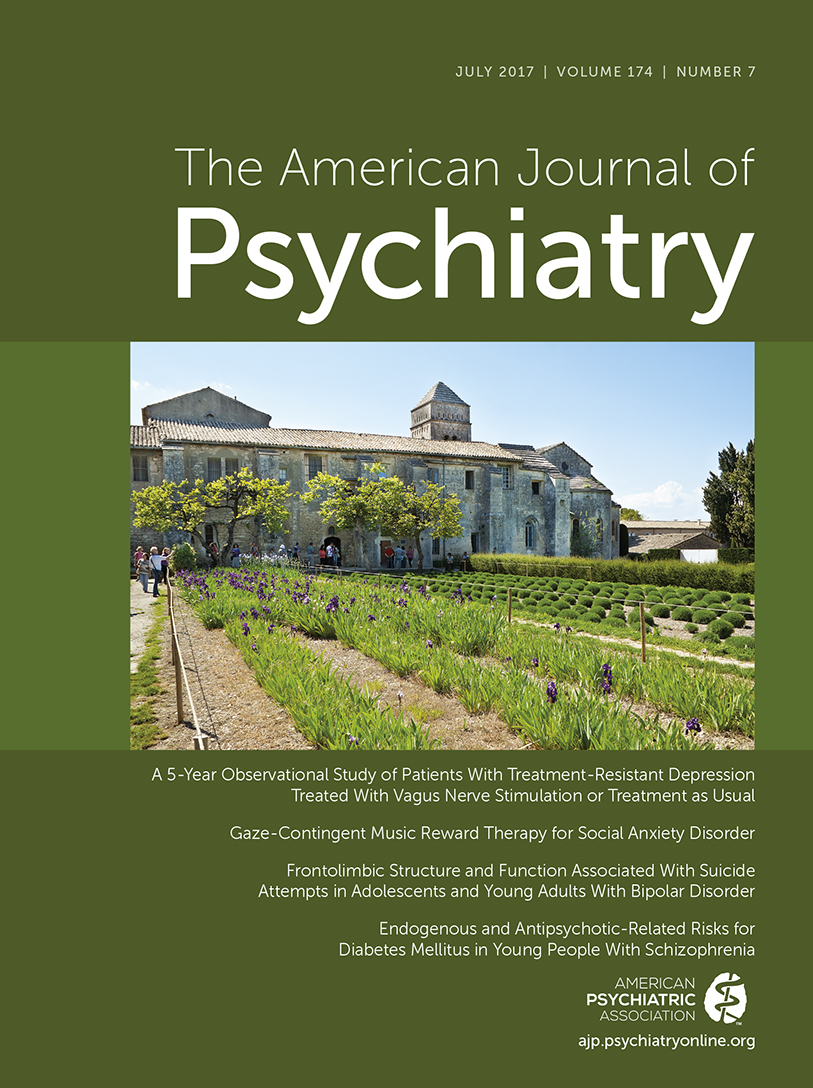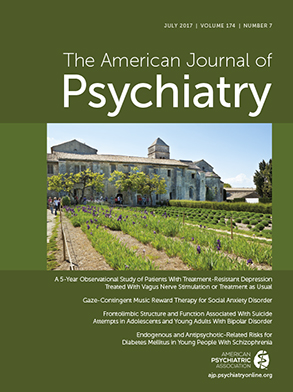Vincent Van Gogh’s paintings are instantly recognizable by their swirling lines, unique composition, turbulent brush strokes, and intense, startling juxtaposition of colors. Visual and emotional engagement with the natural world from childhood until his death was central to his artistic inspiration (
1).
Not only was Van Gogh a great painter, essentially unrecognized in his lifetime, he was a brilliant writer. He bequeathed to us a remarkable body of correspondence that provides considerable insight into his mental life and his poignant, tragic struggle with the psychotic illness that was to claim his life (
2).
In April 1889, he wrote, “What consoles me a little is that I’m beginning to consider madness as an illness like any other and accept the thing as it is, while during the actual crisis it seemed to me that everything I was imagining was reality” (2, p. 656).
Van Gogh shortly thereafter was hospitalized in the asylum of Saint-Remy, where he suffered intermittent psychotic episodes. In a period of lucidity he wrote to his brother Theo, “Anyway my dear fellow, we must accept it, the illnesses of our time, all in all it’s only fair that having lived for years in relatively good health, sooner or later we have our share of them. As for me, you’ll feel a little that I wouldn’t have chosen madness if there had been a choice but one can’t catch it anymore” (2, p. 657).
During his time in this benign and progressive institution, Vincent’s custodians provided him with a studio and encouraged his painting. While there he painted his classic Starry Night (now in the Museum of Modern Art, New York City). He was beset, however, by recurrent psychotic episodes. He wrote, “I cannot possibly describe what the thing I have is like; there are terrible fits of anxiety—without any apparent cause—or then again a feeling of emptiness and fatigue in the mind. I consider the whole rather as a simple accident, no doubt a large part of it is my fault, and from time to time I have fits of melancholy, atrocious remorse” (2, p. 661).
His correspondence with Theo was of critical positive therapeutic importance. “Your kind letter did me good today” (2, p. 661). The constant blows to his self-esteem engendered by his illness are captured in a letter to his sister: “It’s quite odd perhaps that the result of this terrible attack is that in my mind there’s hardly any really clear desire or hope left, and I am wondering if it is thus that one thinks when with the passions somewhat extinguished, one comes down the mountain instead of climbing it” (2, p. 666).
Van Gogh was comforted by his acute awareness that those around him in the asylum shared elements of his disorder: “Speaking of my condition, I’m still so grateful for yet another thing, I observe in others that, like me, they too have heard sounds and strange voices during their crises, that things appeared to change before their eyes. And that softens the horror that I retained at first of the crisis I had and which comes to you unexpectedly, cannot but frighten you beyond measure. Once one knows that it’s part of the illness one takes it like other things. Had I not seen other mad people at close hand I wouldn’t have been able to rid myself of thinking about it all the time” (2, p. 671).
Aware that effective somatic medical treatments for his illness were nonexistent, he shrewdly observed the therapeutic potential of the doctor-patient relationship: “The doctors… do you know what they can do all the same—they give you a more cordial handshake, greater than many hands, and their presence can really be very pleasant and reassuring sometimes” (2, p. 661).
By 1890, Van Gogh was eager to leave the asylum, but he possessed sufficient insight to recognize that he needed a physician who would continue to monitor his case. He moved to Auvers-sur-Oise, a rural village north of Paris and placed himself in the care of Dr. Paul Gachet, whom he subsequently painted in a series of now-famous portraits. To Theo he wrote, “Anyway, père Gachet is a lot, yes a lot like you” (2, p. 780) and “Then I’ve found in Dr. Gachet a ready-made friend and something like a new brother would be…he’s very nervous and very bizarre himself. I did his portrait the other day” (2, p. 781). While in Auvers-sur-Oise he commented, “Ah, if I’d been able to work without this bloody illness! How many things I could have done, isolated from the others, according to what the land would tell me. But—yes—this journey is well and truly finished” (2, p. 730). An ominous note, given what was about to occur. In July 1890, Van Gogh went to paint in the fields outside Auvers and then proceeded to shoot himself in the chest. He died 2 days later.
Van Gogh’s voyage through madness and its tragic outcome, together with his extraordinary artistic achievement, pose many questions. Are his illness and his unique creativity linked or was his psychosis an adventitious and destructive element that recurrently derailed his artistic genius? His letters suggest the latter.
A recent exhibit and conference at the Van Gogh Museum in Amsterdam called “On the Verge of Insanity” focused on this issue (
3). Various diagnostic hypothesis were promulgated, including digitalis toxicity, to explain his intense use of the color yellow and the presence of haloes in his last paintings. This was based on his portraits of Dr. Gachet holding a foxglove plant and the assumption that Gachet prescribed it to his patient, as it was used then in the treatment of epilepsy—another putative diagnosis for Van Gogh. However, it seems most likely to me that Van Gogh suffered from a recurrent bipolar illness that at times may have intensified perception and thus found its way into the intense and unusual use of color in his paintings. However, the disorder, as he eloquently expressed, was inimical to his heroic creative achievements.


